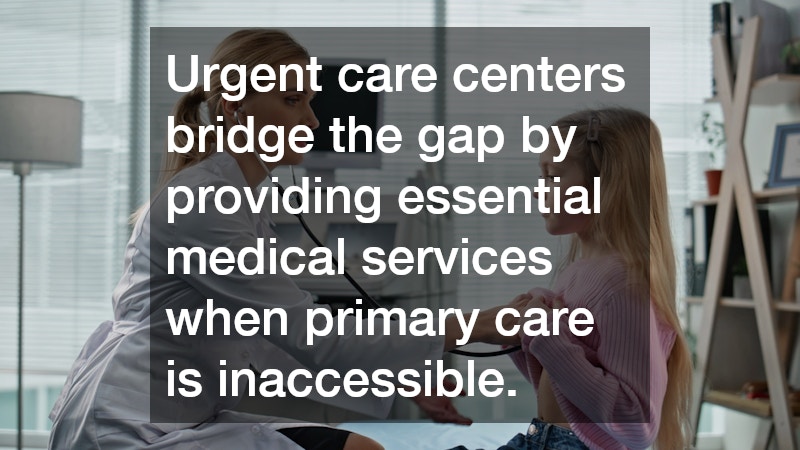How Urgent Care Gives Your Child the Care They Need When it Matters Most
When a child falls ill or sustains an injury, every moment counts. Parents often face stressful situations when dealing with sudden health issues that arise after hours or on weekends. Traditional healthcare facilities, like general practices, may not be convenient or available in these critical moments.
Urgent care centers bridge the gap by providing essential medical services when primary care is inaccessible. These facilities are designed to handle non-life-threatening emergencies quickly and efficiently, ensuring that children receive prompt attention.
Having access to urgent care for children provides peace of mind to parents who want the best for their kids.
Moreover, an urgent care center’s ability to offer walk-in appointments means that waiting times are often significantly reduced compared to emergency rooms. This can be crucial, especially when dealing with a sick or injured child who needs immediate care. By opting for urgent care, families can avert the unnecessary stress of long waits and receive timely medical support.
What to Expect at an Urgent Care Visit
Urgent care centers are equipped with medical professionals who are trained to attend to a variety of pediatric cases swiftly. When you walk into an urgent care for children, you can expect a welcoming environment tailored to ease the anxiety that a child may feel when visiting a healthcare facility. The staff understand the unique needs of children, ensuring a compassionate approach to treatment.
During a visit, a comprehensive assessment will be carried out to ascertain the most effective treatment plan. Medical professionals include pediatricians, nurses, and support staff who work together to deliver quality care. These experts are adept at managing common childhood ailments like fevers, minor fractures, and infections, among others.
In addition to immediate care, urgent care centers often provide diagnostic services such as X-rays and lab tests, offering a one-stop solution for many medical concerns. Having onsite diagnostics ensures that children receive accurate and immediate treatment, minimizing the need for referrals to other facilities. This holistic approach enables parents to address their child’s health needs efficiently during a single visit.
The Benefits of Choosing Urgent Care Over the Emergency Room
Urgent care for children is a cost-effective alternative to emergency rooms, particularly for non-severe medical issues. The costs associated with emergency room visits can be significantly higher, yet the level of care required may be the same as what an urgent care center provides. For families, avoiding exorbitant ER bills while still receiving appropriate care is a considerable advantage.
Another benefit is the reduced exposure to more severe cases, which is often a concern for parents in hospital settings. Emergency rooms are designed to prioritize the most critical cases, which may result in longer waiting times for those with minor illnesses or injuries. In contrast, urgent care centers focus on treating non-life-threatening issues promptly, thus decreasing waiting times considerably.
Additionally, urgent care facilities are generally strategically located, making them more accessible to families. They often have extended hours, open on weekends and evenings, which fits well with the hectic schedules of modern families. The convenience of location and timing ensures that children receive timely care when it matters most.
Urgent Care as a Continuum of Care for Children
Urgent care centers play a vital role in the continuum of care essential for maintaining a child’s health. They act as a bridge between routine pediatric checkups and emergency care, ensuring continuous support during unexpected health episodes. This ensures that any medical issues are addressed before they escalate into more significant problems.
The capabilities of urgent care centers complement those of primary pediatricians. While they are not a substitute for regular doctor’s visits, they provide crucial care interventions at times when other facilities are unavailable. By integrating with the larger healthcare network, urgent care centers can also assist in referrals and follow-up appointments for ongoing health concerns.
Further, these centers often maintain communication with a child’s primary healthcare provider, allowing for continuity in medical records and treatment plans. This collaboration ensures that all healthcare providers involved have a comprehensive understanding of the child’s medical history, leading to optimized care. In essence, urgent care not only addresses immediate health needs but also supports the overall well-being of children in the long term.
Preparation can significantly enhance the efficiency and effectiveness of an urgent care visit. Parents should bring an updated list of their child’s medications, as well as details of any allergies and past medical history. This information is vital for healthcare professionals to provide accurate treatments and prevent any adverse drug interactions.
It’s also important to bring along the child’s insurance information to ensure a smooth administrative process. Many urgent care centers accept a wide range of insurance plans, but verifying this ahead of time can prevent delayed care. Additionally, parents should be prepared to articulate the symptoms and any changes they’ve observed in their child’s health to provide a complete picture to the attending physicians.
Lastly, keeping a child calm and comfortable is essential. Bringing along a favorite toy or book can help distract them during the visit. By being prepared, parents can help ensure that the urgent care experience is as positive and stress-free as possible for both themselves and their child.
In conclusion, urgent care for children offers an invaluable service that ensures young ones receive crucial medical attention when it matters most. With their affordability, convenience, and focus on swift care, these centers provide an ideal solution for non-critical emergencies, supporting the overall health and well-being of children.


